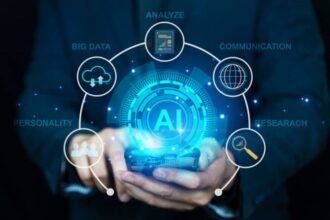Artificial Intelligence (AI) has been steadily making its way into various fields, and UX design is no exception. From automating routine tasks to providing insights through data analysis, AI tools are reshaping how designers approach their craft. However, as AI becomes more advanced, a question arises: Will AI enhance the role of UX designers, or will it replace them entirely? Let’s explore both sides of the debate and what the future might hold.
The Current Role of AI in UX Design
AI is already being integrated into UX design processes in numerous ways. Some of its current applications include:
- User Behavior Analysis: AI tools can analyze vast amounts of user data quickly and identify patterns that might take humans much longer to discover. This helps UX designers make data-driven decisions faster and more accurately.
- Automated Wireframing and Prototyping: AI-driven platforms like Uizard and Figma’s auto-layout feature allow designers to automate certain parts of the design process, such as generating wireframes or resizing components, saving valuable time.
- Personalization: AI allows for creating personalized user experiences based on behavior, preferences, and other data. It can automatically adjust content, layout, or navigation elements to better suit individual users.
- Predictive Design: AI can predict user needs based on past interactions, enabling more intuitive and forward-thinking designs. For example, it might suggest interface changes that can improve usability before issues even arise.
How AI is Enhancing UX Designers’ Roles
“While there’s no doubt AI is powerful, it’s currently more of an enhancer than a replacement for UX designers” Sam from Samantha Digital states. Here are several reasons why:
- Speed and Efficiency: AI can handle repetitive, time-consuming tasks such as A/B testing, heatmap analysis, and even drafting initial wireframes. This frees up designers to focus on more creative, strategic aspects of the design process, like ideation and user empathy.
- Data-Driven Decisions: By offering quick insights based on large amounts of data, AI helps designers make informed choices. For example, instead of manually analyzing user behavior, AI can provide reports that highlight user pain points, allowing designers to focus on addressing them with targeted solutions.
- Better Personalization: AI can personalize user experiences at scale, something difficult for human designers to achieve on their own. This allows for more adaptive and dynamic interfaces that respond to individual user needs.
- Collaboration with AI Tools: UX designers are increasingly working alongside AI-powered tools like Adobe Sensei, Sketch’s AI plugins, and Framer. These tools offer intelligent design suggestions, automate repetitive tasks, and even assist in creating responsive designs. Designers who know how to leverage these tools can increase their productivity and creativity.
Limitations of AI in UX Design
Despite its growing capabilities, AI still has limitations when it comes to replacing human designers” Kat from The Berlin Web Designer states. Some of these limitations include:
- Lack of Creativity: AI excels at automating tasks based on rules and patterns, but creativity and innovation are inherently human traits. Designing an emotionally resonant, aesthetically pleasing experience still requires human intuition, empathy, and a deep understanding of users’ desires.
- Human Empathy: At the heart of UX design is empathy—understanding users’ pain points, emotions, and needs. While AI can analyze user data, it can’t feel what a human feels. AI might suggest a design based on data, but only a human designer can ensure that the design truly resonates with users on an emotional level.
- Contextual Understanding: AI lacks the ability to fully grasp cultural, social, and contextual nuances. For example, a chatbot might recognize the words in a user’s query, but it may not understand the underlying emotion or context, which is critical in designing user-centered experiences.
Will AI Replace UX Designers?
The short answer is no, not entirely. AI is unlikely to replace UX designers, but it will change the nature of their work. The more likely scenario is that AI will continue to enhance the UX design process, helping designers work faster, make data-driven decisions, and create more personalized experiences. However, the human element—creativity, empathy, and strategic thinking—remains irreplaceable.
AI as a Tool, Not a Threat Rather than viewing AI as a threat, UX designers should see it as a powerful tool to improve their workflow. Designers who embrace AI can become more efficient, innovative, and data-driven in their approach. Those who ignore AI risk falling behind in an industry that is increasingly tech-driven.
The Future of AI and UX Design Looking ahead, AI’s role in UX design will likely grow, but the human touch will remain crucial. As AI continues to evolve, designers will need to adapt by learning how to collaborate with AI systems effectively. Skills like creative problem-solving, empathy, and strategic thinking will become even more valuable, while tasks that can be automated will become less central to the design process.
Conclusion: AI and UX Design – A Symbiotic Relationship
AI isn’t here to replace UX designers but to enhance their capabilities. The most successful designers of the future will be those who can harness the power of AI to deliver better, more personalized user experiences while continuing to provide the creativity and human empathy that machines cannot replicate. By working with AI rather than against it, UX designers can stay ahead of the curve and continue shaping user experiences in a meaningful way. Next steps: to learn more about if ai will replace ux designers, be sure to check out this post.

















